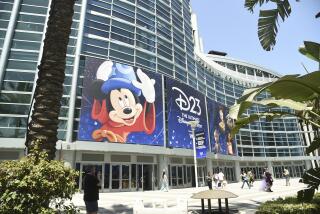N.Y.’s 1939 World’s Fair: A Look Then at World We’re Living in Now
- Share via
NEW YORK — In many a dresser drawer across the country, amid the faded snapshots and other keepsakes, there is a plastic pickle, a souvenir of a splendiferous tomorrow that came and went.
Fifty years ago, in the interlude between the Great Depression and World War II, the pickle’s owner had gone to Flushing, Queens, to discover a sleek and glittering future and had set up camp on 1,216 acres of reclaimed ash heap.
The visitor to the 1939 New York World’s Fair came away with visions of televisions and superhighways, of nylon stockings and automatic milking machines, of man-made lightning and aerated bread--all this and a pickle pin, one of 6 million distributed at the H. J. Heinz pavilion.
Showered, Milked Cows
Fair-goers saw the Walker-Gordon Rotolactor, a revolving platform on which five cows were showered, dried with sterile towels and mechanically milked. They watched the 7-foot-tall Westinghouse robot, Elektro, and his “moto-dog,” Sparko. They toured 200 buildings--each of them spectacular--and saw 175 sculptures and 105 murals.
“Everything was unfamiliar--they were dazzled by what the future could be,” says Barbara Cohen, author with Steven Heller and Seymour Chwast of “Trylon and Perisphere: The 1939 New York World’s Fair.”
That was the aim of the fair’s organizers--that and bringing tourist dollars to New York. The city’s business elite had been impressed by the 1933 Century of Progress fair in Chicago. They proposed a fair to mark the 150th anniversary of President George Washington’s inauguration in New York.
Grover A. Whelan, former police commissioner, head of a distillery and the bow-tied barker boss of the 1939 World’s Fair, said at the time: “By giving a clear and orderly interpretation of our own age, the fair will project the average man into the World of Tomorrow.”
The symbols of the fair were two abstract shapes that were at once classic and modernistic--the Trylon, a 610-foot spike, and the globular Perisphere, a theater twice the size of Radio City Music Hall that housed Democracity, a multimedia depiction of the city of the future.
Radio commentator H. V. Kaltenborn narrated the six-minute show: “As day fades into night each man seeks a home, for here are children, comfort, neighbors, recreation--the good life of a well-planned city.”
Diorama of the Future
The same theme was struck at the fair’s most popular exhibit, General Motors Corp.’s Futurama, where 552 moving chairs carried fair-goers past a diorama depicting the United States, circa 1960--a place where seven-lane, radio-controlled highways moved teardrop-shaped cars at 100 m.p.h.
In the future, the narrator said, cars would be air-conditioned. He was right. He said they would cost as little as $200. He was wrong.
“The land is much greener than it was in 1939 . . . . Men love their fields and gardens better and more wisely,” Life magazine wrote of Futurama.
Spectators often waited in line two hours to see Futurama, but there was so much to do, and so little time!
They ran to the AT&T; building to see the VODER, a speech synthesizer, and to enter a contest for a free long-distance call. They ran to the Dairy World of Tomorrow to meet Elsie the Cow. They ran to the DuPont exhibit to witness the wonders of nylon, Lucite and cellophane, and to RCA to see the first regular television broadcasts.
The home of tomorrow was shown at General Electric, which offered a kitchen with appliances that talked, and at Westinghouse, which pitted “Mrs. Drudge” doing dishes the old-fashioned way against “Mrs. Modern,” who used a dishwasher. Then there was Tomorrow Town, a collection of 15 model homes.
The fair was not entirely commercial--60 nations, including the Soviet Union, opened pavilions in Flushing Meadows--but there is no doubt the World of Tomorrow was a world of salesmanship.
‘Heinz Jousting With Beech-Nut’
Writer E. B. White hoped to find “the field of honor” at the fair, but found instead that it was “merely Heinz jousting with Beech-Nut--the same old contest on a somewhat larger field, with accommodations for more spectators, and somewhat better facilities all round.”
Others found fault with the fair’s crowd-pleasing amusement zone, which featured a Parachute Jump and Billy Rose’s Aquacade, as well as more tawdry diversions like sideshows and bare-breasted women--offered, of course, as educational exhibits on the life styles of the Amazons.
The amusements took precedence in 1940, when it became clear that the fair was in trouble. With the advent of World War II, the Soviet pavilion and others closed. The Trylon and Perisphere were in bad repair as temporary structures that were not designed to withstand the weather.
More importantly, the fair was losing money. Most critics argued that the 75-cent admission fee was too high. A full day at the fair for two people, including meals, cost about $7--a high tariff at the end of the Depression.
Fair officials expected 50 million visitors in 1939. Attendance fell short of that mark after two years running. The fair lost nearly $19 million.
This did not prevent New York from trying another world’s fair at the same spot 25 years later. That fair, too, was a financial fiasco, and it is not recalled with the same intensity and fondness as its predecessor.
“It seemed more tawdry than the 1939 World’s Fair,” said author Cohen.
Traveled Less, Had No TVs
The people who attended the 1939 fair were not so world-wise as their children would be. They traveled less, had no television to bombard them with images of an unobtainable good life, had never eaten foods of foreign lands.
“It was a simpler time, truly,” Cohen says.
She operates an antique bookstore for New York topics. The children and grandchildren of fair-goers visit her shop and buy Trylon and Perisphere ring-toss sets, ashtrays, bookends, pennants, doilies, postcards and license plates, as well as pins that say: “I have seen the future.”
Why do people who were not alive when a fair blossomed in Flushing seek out these mementos? “It’s a gene memory,” she says.
One souvenir remains buried at Flushing Meadows: a time capsule containing bits of 1930s life, so that people who lived in the future foretold by the fair could know a bit more about the past.
Denizens of the future will find sheet music to “Flat Foot Floogie.” A Mickey Mouse cup. Newsreel footage, including the film of Jesse Owens’ triumph in the 100-meter dash at the 1936 Olympics.
More to Read
The biggest entertainment stories
Get our big stories about Hollywood, film, television, music, arts, culture and more right in your inbox as soon as they publish.
You may occasionally receive promotional content from the Los Angeles Times.










